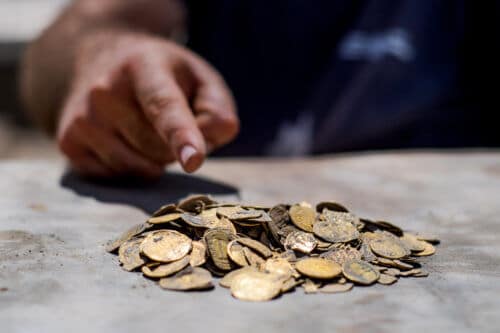Cache נRevealed by apprentices of a year of service in the excavation of the Antiquities Authority in the center of the country
An impressive and rare cache of coins from the Abbasid period, from about 1,100 years ago, was uncovered by apprentices of a service year in an archaeological excavation of the Antiquities Authority funded by the Israel Lands Authority, in preparation for the establishment of a neighborhood in the center of the country.
As part of the Antiquities Authority's policy to include teenagers in the archaeological excavations in order to bring them closer to the past, teenagers work in the excavations during the summer vacation and boys and girls in a year of service before being drafted into the IDF.
Last Tuesday, when the trainees of the "Culture Movement" service year from Holon arrived to work in the excavation, two of the boys suddenly recognized something shimmering in the ground.
According to Oz Cohen, a trainee for a year of service at the "Cultural Movement" in Holon, "It was surprising. I dug into the soil and when I scooped it out, I saw what looked like very thin leaves. When I looked again I saw that they were gold coins. It was really exciting, to find such a special and ancient treasure".

According to the excavation managers, Liat Nadav-Ziv and Dr. Eli Hadad from the Antiquities Authority, "The treasure, which was deliberately buried in the ground in a clay pot, contained 424 gold coins, most of which date from the early Islamic period and the Abbasid dynasty. The person who buried his treasure 1,100 years ago must have expected to return to take it, and even fixed the vessel with a nail so that it would not move. What prevented him from returning and collecting his possessions? We can only guess. Finding gold coins, certainly in such a considerable amount, is extremely rare. You don't find much of them in archaeological digs because gold has always been valuable, and passed down from generation to generation. The coins, made of a noble metal that does not oxidize with the air, were found in an excellent state of preservation, just as if they had been buried yesterday. Finding them may indicate international trade between the inhabitants of the area and distant areas."
According to Dr. Robert Cole, a coin expert at the Antiquities Authority, "Excavations in Israel are extremely rare in caches from the Abbasid period - especially gold coins. This is one of the earliest known caches from this period (end of the 9th century) in Israel. The coins are made of pure gold - 24 karat. The total weight of the treasure is about 845 grams of pure gold - a significant amount of money for those days. For example, with such an amount a person could buy a luxurious house in one of the best neighborhoods in Postat, the wealthy capital of Egypt in those days. From a preliminary examination of the coins, most of them date to the end of the 9th century AD. During this period, the region was part of the vast Abbasid Caliphate, which stretched from Persia in the east to North Africa in the west, and whose center of government was in Baghdad in Iraq. The hoard consists of full gold dinars, but also - unusually, contains about 270 small gold coins - pieces of gold dinars, which were cut to be used as 'small money'. The minting of gold and silver coins was a permanent feature of the monetary system in Islamic countries after the 9s, with the sudden disappearance of bronze and copper coins.
One of the coins discovered in the excavation is an extremely rare coin, which has never been found in excavations in Israel: a fragment of a gold solidus of the emperor Theophilus (829 - 842 AD), minted in Constantinople, the capital of the Byzantine Empire at the time. The appearance of this small Byzantine coin fragment in an Islamic coin hoard is a rare material evidence of the ongoing ties (war, trade) between the two rival empires during this period.
According to Dr. Cole, "Finding the rare treasure may have a great contribution to research, since the findings from this period in Israel are relatively scarce. We hope that the exploration of the treasure will tell us more about an unknown period in the history of the country."

One response
I hope there is a tight guard there, otherwise antiquities robbers will destroy the site in search of more coins (its location is no secret to those who listened to the video).